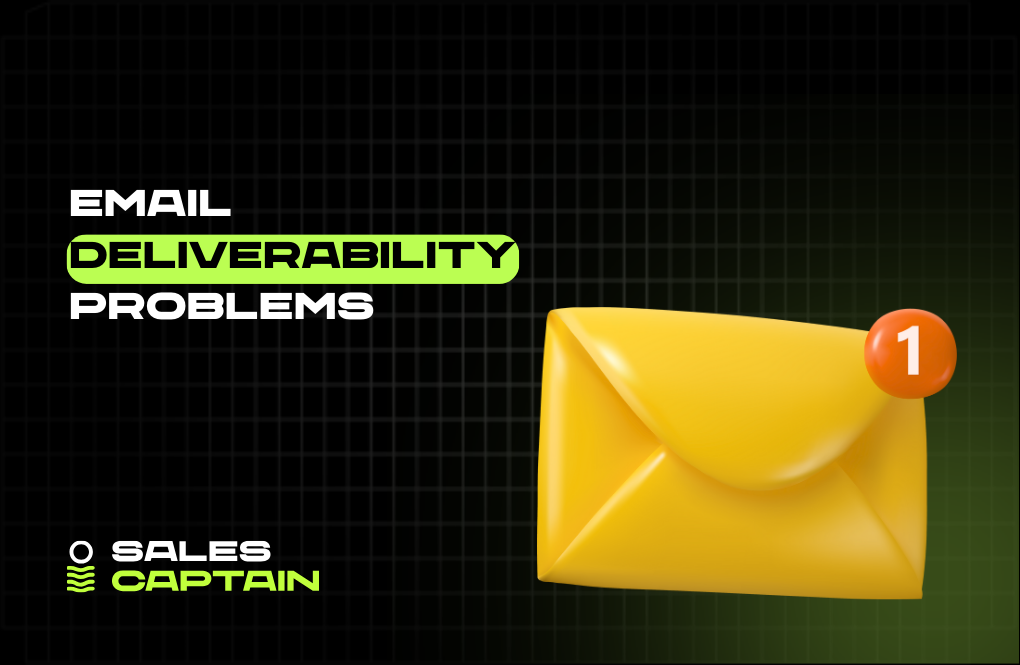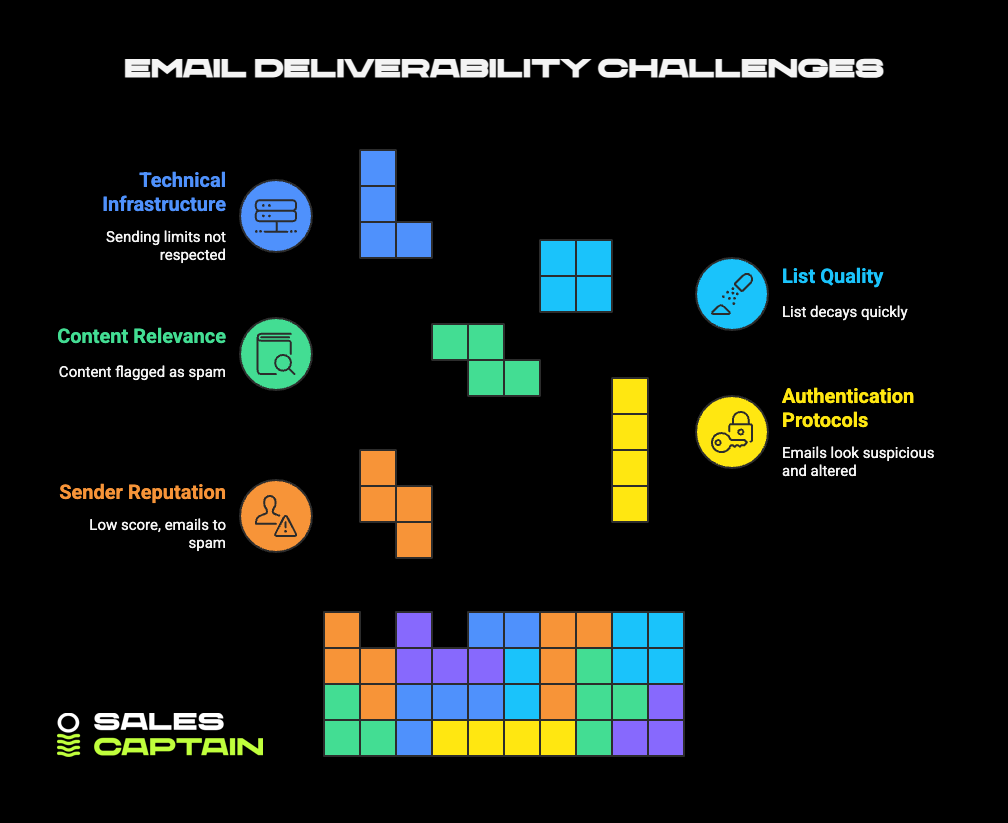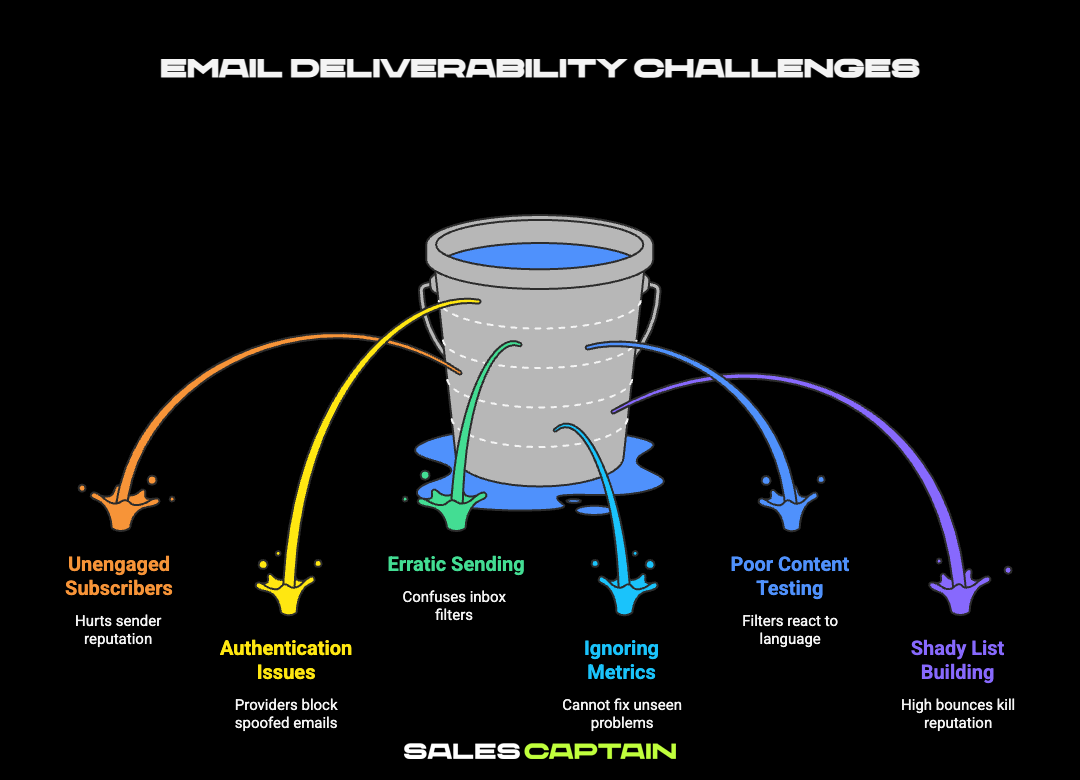

Email Deliverability Problems in 2025: How to Land in the Inbox and Avoid Spam Filters


Understanding Email Deliverability
Definition of Email Deliverability
Email deliverability measures whether your emails actually land in someone’s inbox, not just the server. Hitting “send” doesn’t guarantee visibility. An email might go to spam, hit a filter, or bounce completely. That’s deliverability: the difference between sending and being seen.
Think of it like direct mail. You can print postcards and drop them in the mail, but if the address is wrong or the mailbox is blocked, that message never gets read. Same applies here.
Importance of Email Deliverability in Digital Marketing
You can write the best cold email ever. Doesn’t matter if it never shows up. Deliverability directly affects response rates, domain health, sender reputation, and pipeline momentum.
Especially in outbound, where each touchpoint counts, poor deliverability means wasted effort. You’re throwing darts in the dark. Campaigns underperform, SDRs burn out, marketing blames sales, and the GTM engine stalls.
Fixing deliverability isn't just a technical tweak. It’s a growth lever.
Common Misconceptions About Deliverability
Lots of people think deliverability = open rate. Not true. Someone could open your email (maybe it landed in Promotions), but if 30% of the list never saw it at all, you've got a deliverability issue.
Another myth: “Just don’t send spammy content.” Content helps, but it’s not the only factor. Reputation, authentication, infrastructure, they all play a role. Deliverability is systemic, not cosmetic.
And no, switching platforms won’t magically fix the issue. If your domain is flagged or your IP is cold, the problem goes wherever you go.
Factors Influencing Email Deliverability

Sender Reputation
Importance of Sender Score
Your sender score is like a credit score for your domain or IP. It reflects how trustworthy you seem to ISPs. Low score? Welcome to Spamville.
Major mailbox providers use sender scores to decide inbox vs junk. It’s driven by complaint rates, bounce rates, engagement, and infrastructure consistency.
A bad score means fewer eyeballs. Fewer eyeballs, fewer replies. Fewer replies, slower GTM velocity.
How to Maintain a Good Sender Reputation
Consistency is everything. Throttle volume. Avoid huge list spikes. Warm up new sending domains slowly.
Engagement is another key. If people delete your emails without opening or worse, mark them as spam, that tanks your score.
Monitor bounce rates, prune inactive contacts, and never buy shady lists. Your reputation is fragile, and hard to rebuild.
Authentication Protocols
SPF (Sender Policy Framework)
SPF tells inbox providers which servers are allowed to send on behalf of your domain. If you're using tools like customer.io or outbound automation platforms, set this up first.
Without SPF, your emails look suspicious, like someone spoofing your domain.
DKIM (DomainKeys Identified Mail)
DKIM adds a unique cryptographic signature to your emails. Think of it like sealing an envelope with a tamper-proof sticker. It proves the message hasn’t been altered.
Many email providers won’t take you seriously without DKIM. It’s a technical box worth checking.
DMARC (Domain-based Message Authentication, Reporting & Conformance)
SPF and DKIM handle authentication. DMARC enforces policy. It tells inboxes what to do when SPF or DKIM fail, reject, quarantine, or let it through.
DMARC also gives visibility. You get reports showing who’s sending on your behalf and whether it’s working.
Content Relevance and Quality
Crafting Engaging Email Content
Deliverability doesn't stop at the technical layer. Content plays a huge role.
Subject lines that scream “FREE” or “LIMITED TIME” spike spam flags. Aggressive formatting does too, especially if your HTML structure looks like it was built in 2001.
But pure plain text isn't always better either. What matters: clarity, personalization, intent. If it feels robotic, inboxes sense it, and so do people.
Common Content Mistakes to Avoid
Don't overuse links, especially tracking URLs.
Avoid image-only emails. Spam filters hate them. Same with huge attachments.
And stop keyword stuffing like it’s 2012. Inbox providers use natural language processing now. They know the game.
List Quality and Engagement
The Role of List Hygiene
Even a warm, accurate list decays fast. People change jobs. Domains expire. And if 10% of your emails bounce, your sender reputation takes a hit.
List hygiene is about trimming the dead weight. Remove hard bounces. Suppress unengaged contacts. Don’t keep emailing ghosts.
It’s not just deliverability insurance, it’s pipeline efficiency.
Importance of Opt-In Practices
High-quality opt-ins drive high engagement, which improves future inbox placement.
Whether it’s inbound leads or outbound targets, consent plays a role. Ask for permission or at least signal context if you're doing cold. Tools that personalize at scale help, but consent sets the tone.
If your leads feel tricked into receiving your email, deliverability dies, and so does trust.
Technical Infrastructure
Email Sending Limits and IP Warm-up
Even top-tier emails will hit a wall if you go from zero to 5,000 sends overnight. Domains and IPs need warming.
Start slow. Ramp up volume week-by-week. Gradual consistency signals trust.
Ignore this, and you’ll get throttled, filtered, or blocked.
Dedicated vs Shared IP Addresses
Shared IPs are like co-living spaces. If your neighbor sends spam, your reputation suffers.
Dedicated IPs mean you’re in full control, but require higher volume to maintain credibility.
Start on shared, then move to dedicated if your volume supports it. But monitor both. IP performance directly impacts inbox placement.
Common Email Deliverability Problems
Spam Filters
Understanding How Spam Filters Work
Spam filters score your emails based on a cocktail of data: domain health, engagement, language choices, layout, IP behavior, and content.
They don’t just scan for red flags, they learn over time. So if past sends performed poorly, even clean emails can get flagged.
Signs Your Emails Are Going to Spam
Open rates nosediving? Replies drying up? That’s signal.
You can also run inbox placement tests to see where your emails actually land. Tools like GlockApps or Mail-Tester simulate real inboxes and spot spam triggers.
If Gmail or Outlook routes you to spam, even for clean content, you’ve got a reputation or infrastructure problem to solve.
Blacklisting Issues
Reasons for Being Blocklisted
You get blacklisted when spam traps catch you or recipients report you too often. Other triggers: high bounce rates, link shorteners, suspicious attachments, or repetitive campaign patterns.
Once blacklisted, your emails might not even make it to spam, they just vanish.
How to Check if You're Blacklisted
Start with tools like MXToolbox or UltraTools. Check your IP and domain against major blocklists like Spamhaus or Barracuda.
If you’re on one, most list providers have an appeal process, but it’s better to prevent than to cure.
Bounce Rates
Types of Bounces: Hard vs Soft
A hard bounce means the address is invalid, permanently. Typos. Closed mailboxes. Never existed.
A soft bounce is temporary. The inbox might be full. The server might be down. You can retry softs, but hard bounces should be removed instantly.
Causes and Solutions for High Bounce Rates
Bad data is the usual suspect. Bought lists. Old leads. Executes ghosting your SDRs.
Solution: validate email addresses before sending. Warm up domains. Segment based on recency. Prune aggressively.
Bounce rates above 5%? Time to pause and clean house.
Strategies to Improve Email Deliverability

Regularly Removing Unengaged Subscribers
Mailbox providers track engagement. If people aren't opening or interacting, they assume you're irrelevant, and route you to spam (or worse, junk status).
Cut the dead weight. Clean your list every 30 to 60 days. It may feel counterintuitive, but fewer emails to active contacts beats more emails to no-shows.
Implementing Proper Authentication
Set up SPF, DKIM, and DMARC. Without these, you’re putting your trust in luck, not infrastructure.
These protocols don’t just protect against spoofing, they give mailbox providers the confidence to let your emails in.
Creating a Robust Sending Schedule
Burst sends kill reputation. Throttle your cadence. Figure out the send times that drive engagement, and stick to them.
Erratic send patterns confuse inbox filters and make campaigns harder to debug.
Monitoring and Analyzing Deliverability Metrics
Key Metrics to Track
You can’t fix what you’re not measuring. Watch:
- Bounce rate
- Spam complaint rate
- Open rate trends
- Inbox placement rate
- Click-to-open rate
These form your deliverability health score. Flatline any of these, you're in trouble.
Tools for Monitoring Deliverability
Use Postmark, Mailgun, or SendGrid dashboards if you're sending through them. Or go deeper with GlockApps or InboxAlly for inbox placement.
If you're managing outbound at scale, plug into Clay. It gives you visibility into deliverability patterns across data enrichments and cadence outcomes, and it’s bundled with 3,000 free credits.
Conducting A/B Testing for Content
Test subject lines, intros, CTAs, even signature formats. Inbox filters react to language patterns. Audiences do too.
Don’t just aim for opens. Track for replies. That’s the real engagement signal.
Run A/Bs weekly. Get your feedback loop tight. GTM is a system, tweak, measure, repeat.
Avoiding Shady List Building Practices
Do not scrape lead lists from random sites. Don’t buy data from sketchy vendors with zero transparency.
Bad data isn't just a risk, it’s a liability. High bounces kill domain reputation. Unsolicited outreach triggers blocklists.
If you're scaling outbound, build smart. Agencies like SalesCaptain help teams build clean, permission-friendly pipeline, without resorting to risky shortcuts.
Testing and Monitoring Deliverability
Pre-send Deliverability Testing
Before a big campaign goes live, test it. Use inbox placement tools or send to seed lists that mirror real inbox environments, Gmail, Outlook, Apple Mail, commercial filters.
You'll learn fast if your domain, content, or structure is off.
Using Email Testing Tools
Tools like Mail-Tester or Litmus can help check spam scores, rendering layout, and technical headers. Plug in your email, send a test, and get diagnostic feedback in minutes.
This lets you catch problems before they tank engagement.
Analyzing Campaign Performance Post-Send
After sending, don’t just glance at the open rate. Dig deeper.
- Did Gmail tank your performance?
- Were Outlook users more engaged?
- Did replies cluster around a specific phrase or CTA?
- Was the time zone off?
The answers guide your next tweaks. A/B test. Rinse. Iterate. That’s how great campaigns stay great, and how weak ones grow.## Addressing Deliverability Challenges
Action Steps When Emails Are Not Delivered
First, confirm whether you're dealing with delivery failure or deliverability failure. If your email bounces, it’s delivery. If it lands in spam or never gets seen, that’s deliverability.
Here’s how to troubleshoot quickly when emails aren't hitting inboxes:
- Run inbox placement tests using tools like Mail-Tester or Gmail seed lists.
- Check for SPF, DKIM, and DMARC misconfigurations. A missing or broken record can kill inbox placement.
- Review bounce logs. Are they hard or soft? High bounce rates usually mean list quality or domain warm-up issues.
- Scan your sending domain inside tools like MXToolbox. Are you blacklisted?
- Look for engagement issues. A sudden drop in opens or replies could mean Gmail moved you to spam.
Sometimes deliverability drops come with no warning. That’s why senders should implement baseline monitoring tools and always test before major campaigns.
If you’re scaling cold outreach in bulk, your deliverability stack should be part of your GTM system, not an afterthought.
Remediation Steps for Blacklisting
You've just found your domain or IP on a blacklist. That doesn’t mean you're doomed, but you do need a prompt, methodical fix:
- Identify which blacklist you’re on. Some (like Spamhaus) carry more weight than others.
- Audit your recent sends. Were there sketchy links, high bounce volumes, or spam triggers?
- Pause all campaigns using the blacklisted domain or IP.
- Reach out to the blocklist provider with a professional removal request. Many have a form. Others expect an email. Be honest, explain what changed, and share any fix you made.
- If you're on a shared IP and your neighbor caused the problem, you’ll want to move to a dedicated IP fast.
- Use pre-send reputation monitors to avoid this next time.
Blacklists penalize bad behavior, but half the time the bad behavior is accidental. Either way, repeat offenders have a harder path to recovery. React fast and clean house.
Dealing with Spam Complaints Effectively
Spam complaints are reputation poison. Too many, and you’re not just flagged, you’re ignored.
Here’s how to deal:
- Track complaint rates through your ESP or outbound platform. Anything above 0.1% is a red flag.
- Segment your data tighter. Relevance reduces friction. The more aligned the send, the fewer the complaints.
- Use clear unsubscribe links. It’s better someone leaves your list than reports you.
- Refine personalization. Robotic intros and mass-blasted templates spike complaints.
- Trim unengaged contacts regularly. Lack of engagement = frustration = complaints.
- Run smaller sends. Fewer recipients means more control, especially during testing.
Spam complaints aren’t just about content, they’re about sender fit. If your list feels off, your outcomes will be too.
FAQs
Delivery means your email was accepted by the recipient’s server.
Deliverability means your email made it to the inbox, not spam, not quarantined. Delivery is a technical success. Deliverability is a visibility success.
You can have 100% delivery and still land in the Promotions tab or spam folder. That’s why deliverability conversations are about reputation, engagement, and infrastructure, not just bounce rates.
You can’t see your exact "score," but you can interpret signals:
- Google Postmaster Tools for Gmail-specific insights (domain reputation, spam rate, etc.)
- Microsoft SNDS for Outlook delivery reputation
- Inbox placement tests using tools like GlockApps to see where your emails land
- Blacklist scans via MXToolbox or UltraTools
- Bounce and complaint rates inside your ESP
Reputation is behavioral. Bad bounce rates, poor engagement, spam complaints, all feed the machine.
Treat your domain like a brand asset. Monitor it like your pipeline.
If you're hitting Gmail's Promotions tab, you're not necessarily doing something wrong, but you're also not front-and-center.
Promotions tab triggers include:
- Too many images
- Marketing-y language (sale, free, limited time)
- Tracking links, especially multiple
- Mass send behavior
- HTML-heavy formatting
Plain-text templates with light personalization usually dodge the promotions filter. It’s not a guarantee, but less “campaign,” more “conversation” is the vibe that lands in Primary.
Don’t try to manipulate the tab. Just write better, cleaner emails. User engagement will move you up naturally.
Prevention beats removal. Stick to these:
- Never buy or rent lists.
- Verify every address before sending. Use your enrichment tool or an email verifier to strip out junk.
- Warm up new domains and IPs slowly.
- Monitor bounce and complaint rates per campaign.
- Don’t overload links. And avoid URL shorteners, they're trigger magnets.
- Rotate templates and avoid spammy language (free, now, urgent).
- Set up SPF, DKIM, and DMARC before your first send.
If outbound is key to your GTM engine, clean infrastructure and smart segmentation aren't optional, they’re table stakes.
Minimum: every 30 to 60 days.
But if you’re sending cold outbound daily, or running multi-step sequences, weekly monitoring may be smarter.
Here's your hygiene cadence cheat sheet:
- Remove hard bounces instantly.
- Suppress anyone who hasn’t opened after 3-5 touches.
- Look for signals, if the domain is invalid or recently bounced, don’t try again.
- Before big new campaigns, run your entire list through a validation tool.
Don’t wait for spam complaints or domain warnings. Deliverability loss is quiet, then sudden. Clean lists = fast GTM motion.
RELATED ARTICLES
Check out more articles on our blog!
RELATED ARTICLES
Lorem ipsum dolor sit amet, consectetuer adipiscing elit, sed diam nonummy nibh euismod tincidunt ut laoreet dolore magna aliquam erat volutpat.




.jpg)





